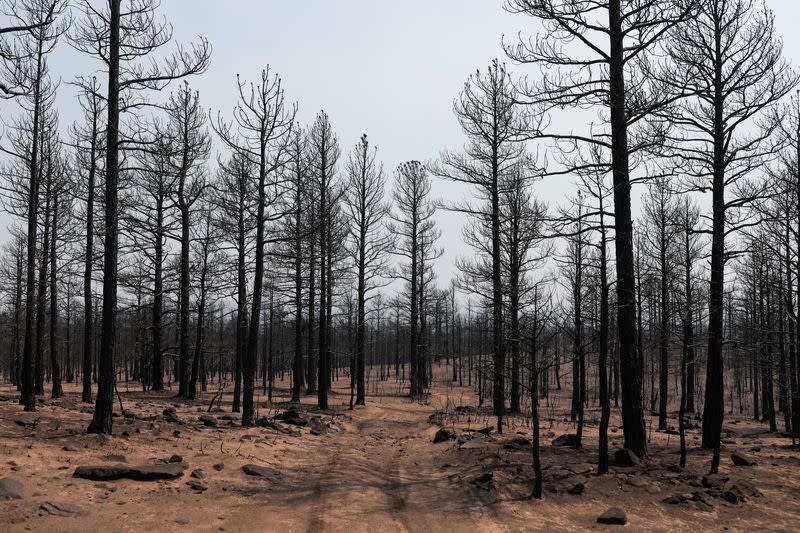In New Mexico, an unlikely wildfire thinning alliance

- Oops!Something went wrong.Please try again later.
By Andrew Hay
TAOS, N.M. Reuters) - A unexpected alliance between traditional woodcutters and federal land managers in New Mexico could provide a model for a push by President Joe Biden's administration to thin forests near villages and towns at risk of climate-driven wildfires.
Near Taos in northern New Mexico, Vicente Fernandez, a mayordomo, or forest caretaker, cut saplings and seedlings crowding a mature fir tree. He explained he was removing fuel that could supercharge a wildfire.
Until recently, the U.S. Forest Service would not have allowed Fernandez to cut live, small-diameter trees for firewood, fence posts or building materials in forest near his home, even though his family did so from the 1700s until the early 20th Century when the agency began occupying areas of former Spanish and Mexican land grants.
In an about-face, the Forest Service is now paying local woodcutters or leñeros $300 an acre to cut these trees for personal use or sale.
After a spate of large and deadly U.S. wildfires in 2020 that followed a century of fire suppression, the Biden administration and its public land managers moved to dramatically ramp up controlled burns and forest thinning. As part of the strategy, USFS a year ago started what was supposed to have been a controlled burn that exploded into the biggest blaze in the continental United States just south of here.
Some environmentalists oppose Taos County's so called Mayordomo Program, and other thinning, saying it is a waste of time, harms forests and is often a guise for logging.
Fernandez says the project is restoring a lost connection between locals and the forest and helping protect his house if a wildfire breaks out in national forest around a third of a mile away.
"The Forest Service is finally opening its eyes to see that you need to let people into the forest to thin it out," said Fernandez, a retired Army National Guard chief warrant officer 5 who served in Iraq.
FIREPROOF FORESTS?
Thinning in the U.S. West can sometimes mean logging valuable larger trees. The Mayordomo Program mostly targets trees with stems between one and six inches wide that are of no value to commercial loggers but can offer a chance for self employment and an alternative to low-paying jobs in Taos' tourist economy, according to project founder J.R. Logan.
The 2022 Infrastructure Law earmarked $8 billion for forest and land management and Congress designated nearly $6 billion towards wildland fire management.
The annual cost of the Mayordomo Program is budget dust, coming in around $250,000, and areas thinned are relatively small, but Logan said it is changing the way federal land managers and locals view the forest.
"It's a shift towards the Forest Service acknowledging that it doesn't have the resources and capacity to do this work on its own and it needs the local folks," said Logan, 39, a forestry consultant for Taos County.
The USFS lets local mayordomos select locations and the program could be adopted in other states, the agency said.
"The Forest Service believes in helping communities to wisely use the forests," the agency said in a statement.
John Horning, executive director of environmental group Wild Earth Guardians, said forests should be left alone to adapt to climate change and the program may be cutting the most resilient trees. He said it was a distraction from hardening homes against wildfires.
"We cannot fireproof forests, we can fireproof communities," said Horning, who has lived in northern New Mexico for 30 years.
Douglas North, mayordomo on a project near Trampas, around 20 miles southwest of Taos, said homes needed defensible space around them but forests around his village also needed work.
"Let's keep thinning, it integrates the community with the forest," said North, a retired physician's assistant, as he sat in an area of ponderosa pine he and his wife cleared.
(Reporting By Andrew Hay; Editing by Donna Bryson and David Gregorio)

